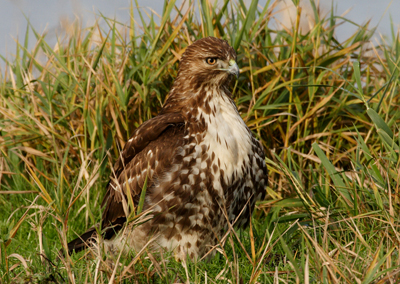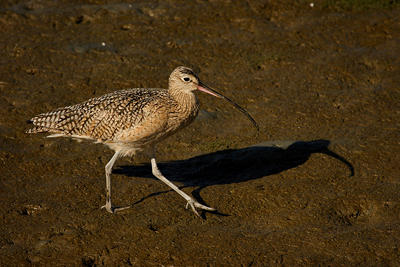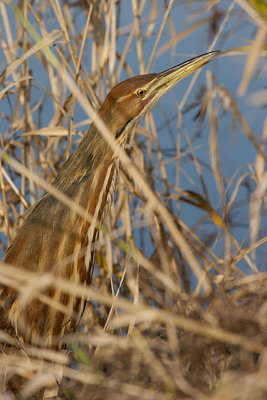Bird Identification

Bird Identification can be fun, but it can also be incredibly challenging and sometimes frustrating. Some of the key tools for identification are things such as: shape, size, color and habitat. Start with the birds you are most familiar with, and learn to identify them properly first. Practice identifying them in different stages of their life, under different light conditions and during different kinds of actions such as perching or flying.
Shape
Shape is the general outline of the bird. Look the bird at the broadest level of description first.
Consider the following questions:
Does it appear short and squat?
Or is it streamlined and tapered?
Does it look long legged and lanky overall?

Then start breaking down the parts and describe how those add to its overall shape. Describe those in an accurate and concise way.
Does it have a short, medium or long beak?
Is the tail moderate or long?
How far back and down do the wings reach when folded, relative to the tail?
Does its chest or belly stick out further, or just appear more noticeable?
Note that in these questions I am comparing parts of the bird to other parts on its body. This is a useful tool for doing quick visual assessments in the field when you only have one bird to look at.
Size
Most of us, even complete beginners, know the relative size of certain birds. We probably all know how big a sparrow, robin, crow and Canada goose is, for instance. You can use the scale of these known birds to compare the bird you are studying by using the four species.
Is your bird smaller than a goose, but larger than a crow? Or is it larger than a sparrow, but not quite robin size?
Using questions in this way leads you to look closer, and making bird identification easily accessible using tools already stored in your memory banks.
Be More Prepared For Your Next Outdoor Adventure!

Don't leave home without knowing these six essential survival skills. Our free survival mini guide reveals the strategies of:
- Shelter & fire to prevent the number one cause of death
- Obtaining clean water to avoid life-threatening dehydration
- Common wild survival foods and other critical skills!

Color
Although colors can sometimes vary subtly depending on lighting, generally well lit birds show obvious colors. Using colors to sort out possible species can be very effective. The red on the breast of an American robin is rather distinct and only appears similar to a very small group of other birds. The dramatically black and white plumage of a magpie is unmistakable. Even just noticing the pale gray of a Bewick's wren's breast and eyebrow line contrasting with its brown upper parts is helpful. It narrows down the potential species that might match that description.
Patterns of color can be helpful, such as the dark spot at the center of a song sparrow's breast where a lot of the streaks on its chest and belly appear to coalesce. Bars of paler and darker colors on the wings of kinglets or some warblers. Watch for these and many others, and use them to narrow down the possible species.
Habitat
Birds are associated with and adapted to specific habitat types. For example, bald eagles and ospreys rarely spend much time away from large lakes, rivers or large bodies of water which contain fish. Red-winged blackbirds are rarely far from cattail marshes. American robins prefer woodland edges that include some open grassland habitat. American bitterns, like the one in the image below are rarely found outside of dense cover such as cattails or rushes in their wetland habitats. Knowing such associations helps you know what species to expect. When trying to key out a potential species using a field guide, always remember to look at the range maps and read the descriptions of preferred habitats.

Final Thoughts on Bird Identification
With the advent and popularity of smartphones, bird identification can be a few clicks away. Remember, though, that even these apps still use these same categories (shape, size, color, & habitat) to help narrow down the search of possible species.
Using these tools of identification, you will greatly increase your chances of success. Go out and enjoy watching birds!
By the way, when you're out birding, it's important to know how to stay safe in the outdoors, especially if you were to get lost. Right now you can get a free copy of our mini survival guide here, where you'll discover six key strategies for outdoor emergencies, plus often-overlooked survival tips.
Additional Resources:
National Geographic Backyard Bird Identifier
Cornell Lab Bird Identification Guide
Learn all about bird identification, bird language & behavior, and many other wildlife skills at Alderleaf Courses.

About the Author: Filip Tkaczyk is a periodic guest teacher at Alderleaf. He also wrote the field guide Tracks & Sign of Reptiles & Amphibians. Learn more about Filip Tkaczyk.
Return from Bird Identification back to Birding Articles
Is The Essential Wilderness Survival Skills Course Right for You? Take the "Online Survival Training Readiness" Quiz
See for yourself if this eye-opening course is a good fit for you. It takes just a few minutes! Get your Survival Training Readiness Score Now!

Grow Your Outdoor Skills! Get monthly updates on new wilderness skills, upcoming courses, and special opportunities. Join the free Alderleaf eNews and as a welcome gift you'll get a copy of our Mini Survival Guide.

 The Six Keys to Survival: Get a free copy of our survival mini-guide and monthly tips!
The Six Keys to Survival: Get a free copy of our survival mini-guide and monthly tips!
Learn more